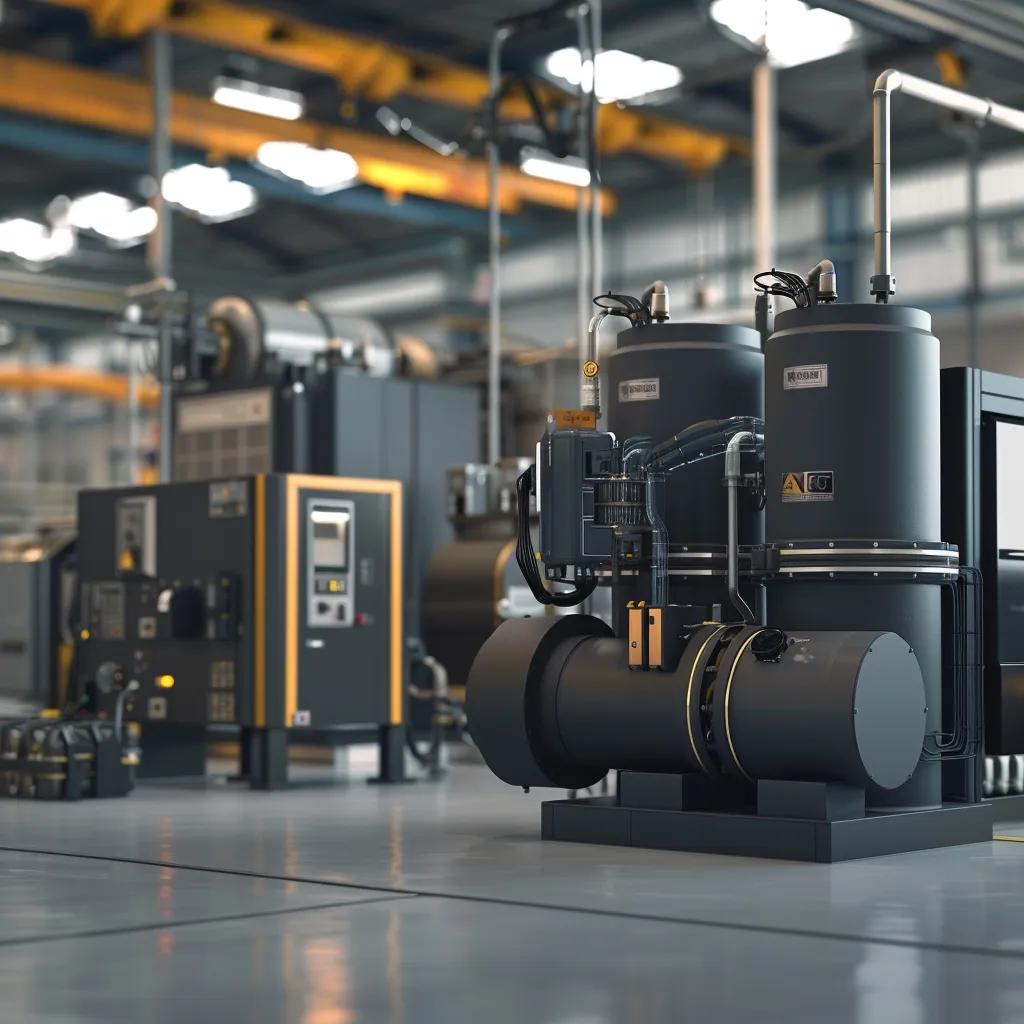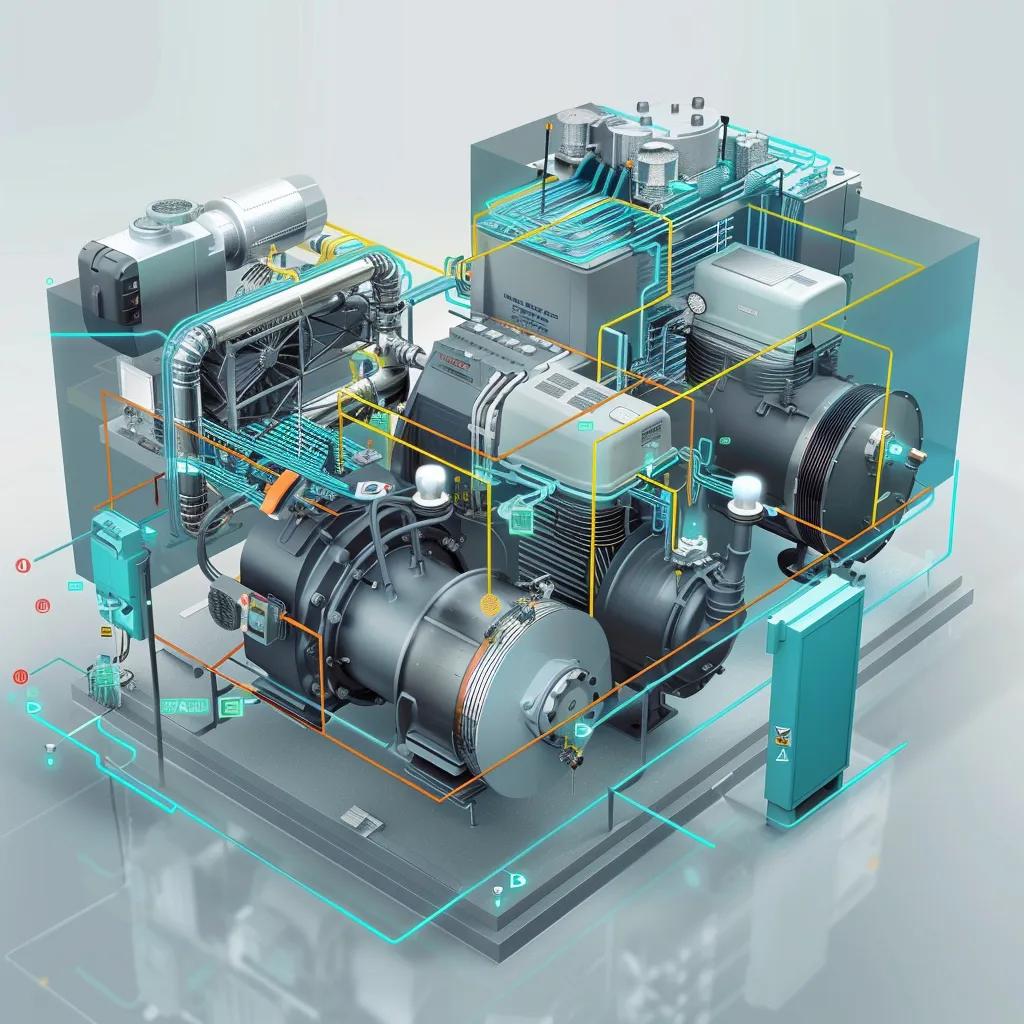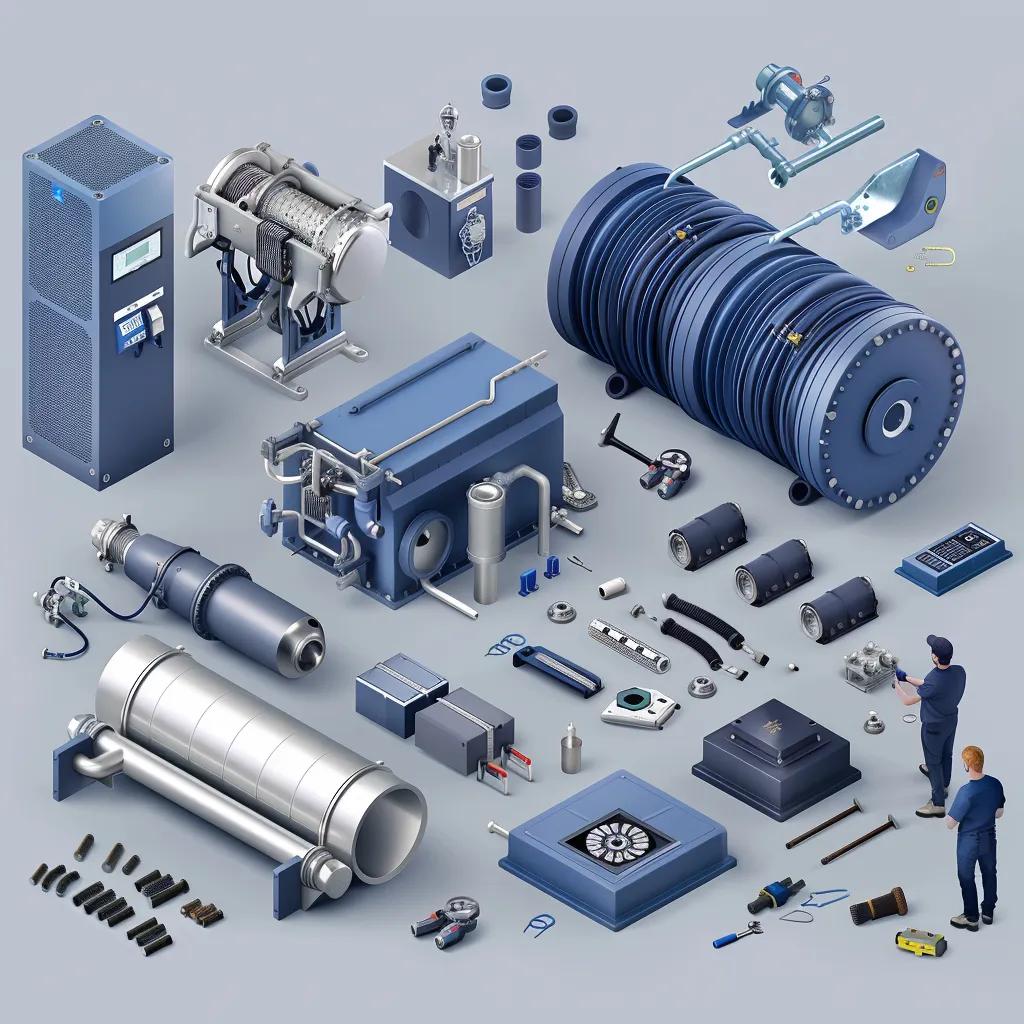
Choosing the right industrial air compressor can make or break productivity, energy bills, and maintenance schedules. This in-depth industrial air compressor comparison explores how rotary screw and piston (reciprocating) compressors differ in design, duty cycle, noise, energy efficiency, cost of ownership, maintenance, application fit, sizing, and environmental impact. It also highlights how C.E.D. Compressed Air—serving Ontario since 1986 with Atlas Copco solutions—supports your selection with tailored sales, service and 24/7 emergency response. Read on for a clear path to the best air compressor for your business needs.
What Are the Key Differences Between Rotary Screw and Piston Air Compressors?
Both rotary screw and piston air compressors use positive-displacement principles to raise air pressure, but their mechanisms, duty cycles and performance profiles differ significantly. Understanding these core distinctions helps businesses match compressor type to operational demands, budget and air quality needs.
| Feature | Rotary Screw Compressor | Piston Air Compressor |
|---|---|---|
| Mechanism | Interlocking helical rotors (screws) | Crankshaft-driven piston in a cylinder |
| Duty Cycle | 100% continuous operation | 20-50% intermittent operation |
| Noise Level | 60-70 dBA (quieter) | 75-85 dBA (louder) |
| Energy Efficiency | Higher (4-5 CFM/HP), VSD options | Lower (3-4 CFM/HP) |
| Initial Cost | Higher capital investment | Lower upfront cost |
| Maintenance | Less frequent, specialized | More frequent, standard parts |
| Durability | Longer lifespan, consistent pressure | Shorter lifespan, pressure fluctuations |
| Ideal Use | Continuous industrial production, heavy-duty | Intermittent tasks, small shops, high-pressure bursts |
Advantages of Rotary Screw Compressors
- Continuous operation capability, ideal for demanding industrial environments.
- Higher energy efficiency, leading to lower operating costs and reduced carbon footprint.
- Quieter operation compared to piston compressors, improving workplace safety and communication.
- Lower maintenance requirements, reducing downtime and labor costs.
- Longer lifespan and consistent pressure delivery, ensuring reliable performance.
How Does the Design and Operation of Each Compressor Type Work?
Piston Air Compressor Operation
A piston air compressor uses a crankshaft-driven piston in a cylinder to compress air into a storage tank. During the intake stroke, air enters the cylinder; on the compression stroke, the piston reduces volume and raises pressure before releasing air through a one-way valve. This reciprocating mechanism delivers high pressures in short bursts, making it ideal for intermittent use scenarios. For example, a small workshop might fire up a piston compressor in cycles of 20–50 percent workload. Next, we’ll contrast this with continuous rotary screw operation.
Rotary Screw Air Compressor Function
A rotary screw air compressor employs two interlocking helical rotors (screws) that draw in and compress air as they turn. Continuous rotary motion lets the machine deliver a steady stream of compressed air without the start-stop cycles of pistons. Variable Speed Drive (VSD) options further refine energy usage by matching motor speed to real-time demand. Because rotary screw units operate at 100 percent duty cycle, they excel in manufacturing lines and heavy-duty environments where uninterrupted airflow is critical. Let’s compare these duty cycles directly.
What Are the Typical Duty Cycles for Each Compressor Type?
| Compressor Type | Duty Cycle | Ideal Use Case |
|---|---|---|
| Piston Air Compressor | 20–50 percent | Intermittent tasks, small shops |
| Rotary Screw Air Compressor | 100 percent | Continuous industrial production |
Piston compressors suit stop-and-go work patterns, while rotary screws guarantee nonstop airflow, setting the stage for an energy-efficiency deep dive.
How Do Noise Levels Differ Between Rotary Screw and Piston Compressors?
Noise levels vary based on design and RPM. Piston compressors typically generate 75–85 dBA due to rapid piston movement and valve operation. Rotary screw units run quieter at 60–70 dBA because fewer moving parts operate smoothly at lower speeds. Reduced noise enhances workplace safety and communication, especially in enclosed facilities. Next, we’ll examine which type offers the best return on energy investment.
Which Air Compressor Is More Energy Efficient and Cost-Effective?

Energy consumption and total cost of ownership (TCO) often make or break compressor decisions. Comparing initial outlay, operational expenses and efficiency features clarifies long-term value.
Why Are Rotary Screw Compressors Generally More Energy Efficient?
Rotary screw compressors typically deliver 4–5 CFM per horsepower, while piston compressors average 3–4 CFM/HP under continuous loads. VSD technology adapts motor speed to airflow demand, cutting power draw during low-demand periods by up to 60 percent. This translates into significant electrical savings and lower carbon footprints. Understanding operating efficiency helps forecast utility costs and ROI.
How Do Initial Costs Compare to Long-Term Operating Costs?
| Cost Element | Piston Compressor | Rotary Screw Compressor |
|---|---|---|
| Initial Purchase Price | Lower upfront cost | Higher capital investment |
| Energy Consumption | Higher per CFM | Lower per CFM with VSD |
| Maintenance & Part Replacements | Frequent | Less frequent, specialized |
| Total Cost of Ownership | Moderate to high | Often lower over lifespan |
Although piston compressors cost less to buy, rotary screws typically return lower lifetime expenses through superior efficiency and reduced downtime. Next, we’ll explore the role VSD plays in squeezing every kilowatt out of your compressor.
How Can You Calculate the Total Cost of Ownership for Industrial Air Compressors?
To evaluate TCO, sum initial investment, projected energy costs (annual kW × hourly rate), maintenance expenses and estimated downtime losses over the equipment’s expected life. For example, multiply average kW draw by duty-cycle hours, then add filter changes, oil, parts and labour plus downtime impact. Comparing these totals for both compressor types reveals the most economical solution.
What Are the Maintenance Requirements and Durability Differences?

Maintenance frequency and component longevity directly influence uptime and productivity. Comparing service needs highlights how each compressor type affects your operation.
What Maintenance Practices Are Recommended for Rotary Screw Compressors?
Rotary screw compressors use a fluid-injected compression chamber that lubricates, cools and seals. Recommended practices include:
- Oil and separator element change every 2 000–4 000 hours
- Intake filter replacement every 1 000–2 000 hours
- Periodic inspection of VSD drive and cooler
Less-frequent servicing reduces labour involvement and scheduling hassles, making fluid-injected rotary screws particularly appealing for 24/7 operations.
How Does Compressor Durability Affect Business Productivity?
High durability equates to fewer unplanned shutdowns. A well-maintained rotary screw compressor often outlasts reciprocating models by years, sustaining consistent pressure delivery. Reduced downtime supports higher throughput and lower maintenance overhead, directly enhancing bottom-line performance.
Which Applications Are Best Suited for Rotary Screw vs. Piston Air Compressors?
Matching compressor type to industry demands ensures optimal performance and cost control. Below are guidelines for selecting between piston and rotary screw units.
When Should You Choose a Piston Air Compressor?
Piston compressors shine in intermittent, small-scale or high-pressure applications such as: high pressure air compressors.
- Tire inflation and pneumatic tools in auto shops
- Sandblasting or spray-gun tasks with cyclical air demand
- Backup or overflow systems where infrequent bursts of air are needed
Their compact footprint and lower initial price fit light-duty installations.
What Industries Benefit Most from Rotary Screw Compressors?
- Large-scale manufacturing and assembly lines
- Process plants requiring constant air for instrumentation
- Construction sites with sustained tool operation
- Food and beverage plants with high-volume filling lines
What Are the Space and Size Considerations for Each Compressor Type?
Piston compressors typically occupy smaller footprints and can fit on shop floors without dedicated rooms. Rotary screw units often require more space for airends, drive systems and coolers, plus ancillary equipment like dryers and receivers. Planning for installation and airflow is critical to ensure efficient operation.
How Do Pressure and Airflow (CFM) Requirements Influence Compressor Selection?
Correct sizing prevents under-performance or wasted capacity. Understanding PSI and CFM interplay guides accurate equipment choice.
What Are Typical PSI and CFM Ranges for Piston Compressors?
Piston compressors often deliver high pressures (100–175 PSI) but at lower continuous flow rates (5–50 CFM). These specifications suit tools and processes demanding periodic bursts of high pressure rather than steady airflow.
How Do Rotary Screw Compressors Provide Consistent Airflow?
Rotary screw units deliver broad CFM ranges (25–1 000+ CFM) at standard pressures (80–150 PSI) without fluctuation. Their smooth delivery supports multiple downstream tools and processes simultaneously, ensuring no tool starves for air.
How Does CED Compressed Air Support Your Choice of Air Compressor?
C.E.D. Compressed Air has delivered customized industrial air solutions in Ontario since 1986. Their expertise helps you navigate the compressor landscape and secure the right equipment.
What Rotary Screw and Piston Compressor Models Does CED Offer?
C.E.D. specializes in Atlas Copco compressors, including:
- Rotary Screw: GA VSD+, GAe, GA/GX ranges for light to heavy-duty continuous use
- Piston: GX series reciprocating compressors for intermittent, high-pressure tasks
How Does CED Provide Sales, Service, and 24/7 Emergency Support?
Beyond equipment supply, C.E.D. offers:
- On-site system audits and sizing consultations
- Preventive maintenance contracts with certified technicians
- Around-the-clock breakdown response across Ontario
Why Choose CED for Tailored Industrial Air Compressor Solutions?
Through decades of industry focus, C.E.D. delivers: air compressors
- Proven Atlas Copco quality and warranties
- Custom system design integrating dryers, filters and storage
- Transparent TCO analysis to guide investment decisions
Their end-to-end approach ensures your compressor aligns precisely with production goals and budget constraints.
What Are the Environmental and Regulatory Considerations for Air Compressors?
Energy standards and sustainability policies shape compressor selection, emissions and operating costs. Aligning with regulations and green goals protects the planet and your bottom line.
How Do Energy Efficiency Standards Impact Compressor Selection?
Government and industry regulations (e.g., DOE standards) mandate minimum efficiency ratings and encourage the adoption of VSD and heat-recovery technologies. Meeting or exceeding these standards avoids penalties and unlocks potential incentives.
What Are the Environmental Benefits of Using Energy-Efficient Compressors?
High-efficiency units reduce electricity consumption by 20–50 percent, cutting greenhouse gas emissions and utility bills. Heat recovery systems can capture up to 90 percent of exhaust heat for space or process heating, further amplifying sustainability gains.
How Are Oil-Free Compressors Driving Market Growth and Compliance?
Stricter contamination regulations in food, medical and electronics sectors are accelerating the shift to oil-free compressors. Zero-oil designs ensure air purity, streamline filter maintenance and support compliance with ISO 8573-1 air quality classes.
Selecting the ideal industrial air compressor hinges on matching design, efficiency, duty cycle and maintenance demands to your operation’s unique requirements. Whether you need the burst pressure of a piston compressor or the uninterrupted flow of a rotary screw unit, C.E.D. Compressed Air stands ready to guide your decision, deliver quality equipment and keep your system running smoothly around the clock. Contact C.E.D. today for a consultation and discover which air compressor is truly best for you.
Still Deciding Between Rotary Screw and Piston Compressors? Let Our Experts Help You Choose the Right Fit!
Navigating the complexities of industrial air compressors can be challenging. Our experienced team at C.E.D. Compressed Air is here to provide personalized guidance, ensuring you select the most efficient and cost-effective solution for your specific operational needs.
Ready to Optimize Your Compressed Air System?
Don’t let the wrong compressor choice impact your productivity and costs. Reach out to C.E.D. Compressed Air for expert advice and tailored solutions. Call Us Today!
